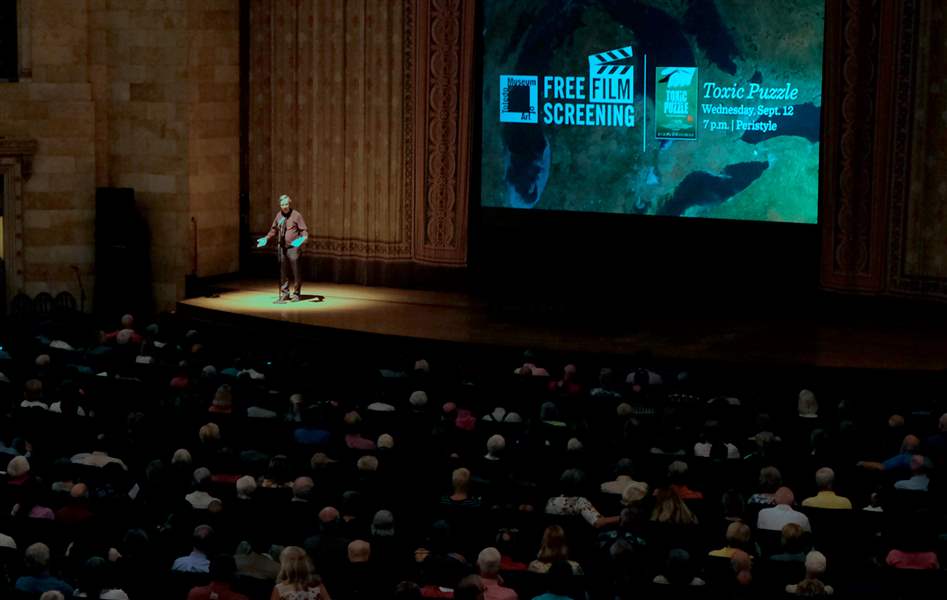
Museum, Rotary vow to up their clean water campaigns at 'Toxic Puzzle' screening
9/12/2018
Toxic Puzzle is shown at the Toledo Museum of Art/Peristyle in Toledo.
THE BLADE/LORI KING
Buy This Image
As hundreds of people filed into the Toledo Museum of Art’s Peristyle in preparation for a special public showing of the film Toxic Puzzle: Hunt for the Hidden Killer, representatives from two influential groups not known for their environmental activism vowed to fight harder against western Lake Erie algal blooms and increase their respective crusades for clean water.
One was the museum itself. Brian Kennedy, museum director, told 80 people attending an invitation-only, pre-screening reception that the museum sees the “challenge and importance of clean water” as a way of keeping the museum relevant and sustainable.
“This is a very, very serious night. It is our responsibility to do something about this challenge. We can. And we will,” Mr. Kennedy said. “Why is this art museum involved? Because we want to be relevant and we want to stay sustainable.”
Likewise, Janina Douglas, Rotary Club of Toledo district water chair, told The Blade moments before the film screening that Rotary is ready to step up a campaign it began shortly after the 2014 Toledo water crisis and take on more of an advocacy role.
“Rotary’s ready to take this from education to advocacy,” she said. “This is part of the puzzle we need to understand.”
Ms. Douglas said Rotary wants to move forward with science-based activism. Its Toledo group, one of the nation’s largest, is supported by Rotary International, which is best known for its decades-old campaign to eradicate polio across the world. Promoting public health through cleaner water is “very much in line with Rotary International’s goals,” she said.
The film shows potential links between an environmental toxin, BMAA, and Lou Gehrig’s, Parkinson’s, and Alzheimer’s diseases.
Paul Cox, the chief scientist behind the film, told The Blade he is thrilled by Rotary’s pledge for greater involvement, calling it a “formidable force.” He also is impressed by the Toledo area’s response to western Lake Erie algal toxins in general. BMAA is one of many varieties of microcystin, the lake’s primary toxin.
“I’m very optimistic. I think people in Toledo can solve the problem,” Mr. Cox said. “But it will need help from Columbus.”
Mr. Cox said he finds it “puzzling there is a resistance to scientific evidence that causes a problem,” from algal blooms to climate change.
Scientists have shown agricultural runoff feeds the algal blooms, yet it’s hard getting meaningful action from the Ohio General Assembly, he said.
“The solution is simple: Stop polluting the environment,” Mr. Cox said. That may require people showing farmers how they could benefit from better farming practices, he said.
Filmmaker Bo Landin said his goal is to provide people information “so they can make educated decisions.”
“It also takes legislative decisions,” Mr. Landin said. “Manure used to be an asset. Today, because of industrial farming, it has become waste and waste has always become a pollution problem.”
He said agriculture, while embracing new technology, might want to consider what past practices worked, too.
Scientists all over the world agree Lake Erie’s chief algal toxin, microcystin, is on the rise across almost every continent and is a bigger threat to the human liver and nervous system than previously thought.
While the science on that is undisputed, Mr. Cox is among a smaller group of researchers who have gone a step further by hypothesizing that microcystin and other toxins in nature might be triggering higher incidences of neurological and brain problems.
The documentary, narrated by actor Harrison Ford, was released in 2017. It makes a case for why such research needs to be accelerated.
On Aug. 9, Mr. Cox was part of a team of researchers that asserted in a scientific paper that it is reasonable to believe South Florida residents “may experience an increased lifetime risk of liver cancer and/or hepatic dysfunction requiring hospitalization or transplantation” as a result of the massive cyanobacteria outbreak in Lake Okeechobee in 2016. The paper was published in the British journal Water Policy. Those blooms were blamed for fish kills and 11 manatee deaths in the St. Lucie River in the vicinity of Stuart, Fla.
Cyanobacteria is the scientific name for microcystis and other forms of blue-green algae that produce a variety of toxins, including microcystin. Technically, microcystis — which, at 3.5 billion years old, is one of Earth’s oldest-living organisms — isn’t algae. It’s bacteria. But it’s commonly referred to as algae because of its bluish-green hue and the way it mats up into scum on the water surface.
BMAA, on the other hand, is one of many different types of toxin — called cogeners — produced by microcystis and other forms of cyanobacteria. Of the nearly 200 varieties of microcystin identified today — about 10 times as many as when the 1998 WHO tap-water guideline was published two decades ago — most of the research is limited to one, called microcystin-LR.
Mr. Cox, who lives in Jackson Hole, Wyo., is perhaps best known for discovering prostratin, an anti-AIDS drug derived from the mamala tree of Samoa. He is an ethnobotanist, a type of scientist who specializes in the way living things are treated or used by different human cultures. In Wyoming, he serves as executive director of Brain Chemistry Labs, a nonprofit research institute.
In 1997, he was named by Time magazine as one of 11 “Heroes of Medicine” for his work. That same year, Mr. Cox, who has a PhD in biology from Harvard University, also shared the world’s most prestigious environmental award, the Goldman Environmental Prize, with Fuiono Senio for their work in saving rain forests in Samoa.
Contact Tom Henry at thenry@theblade.com, 419-724-6079, or via Twitter @ecowriterohio.